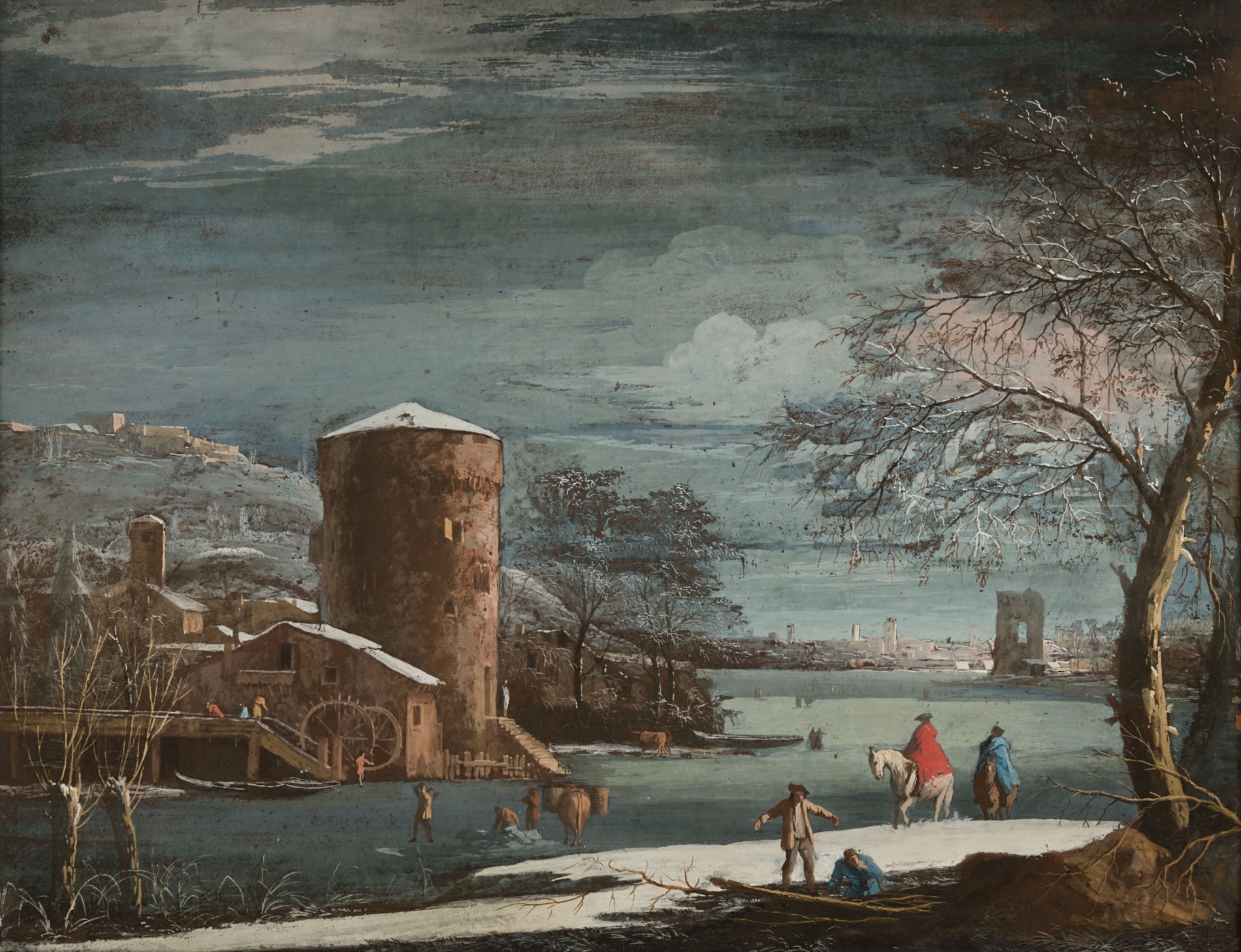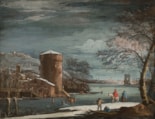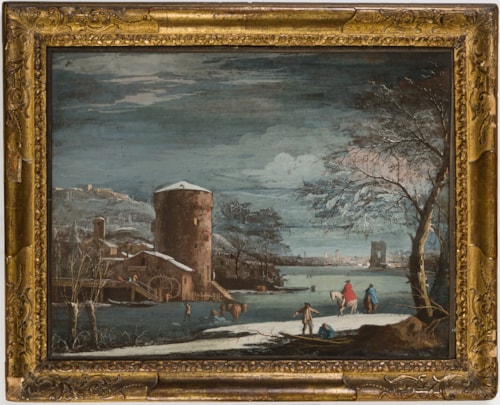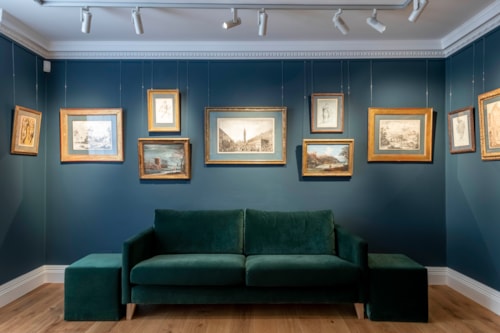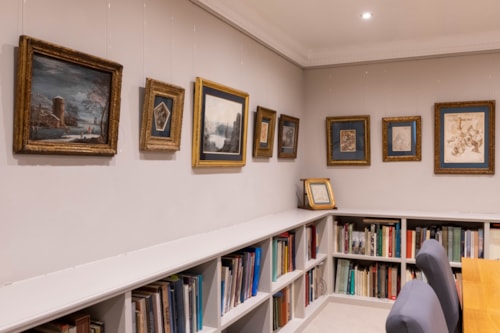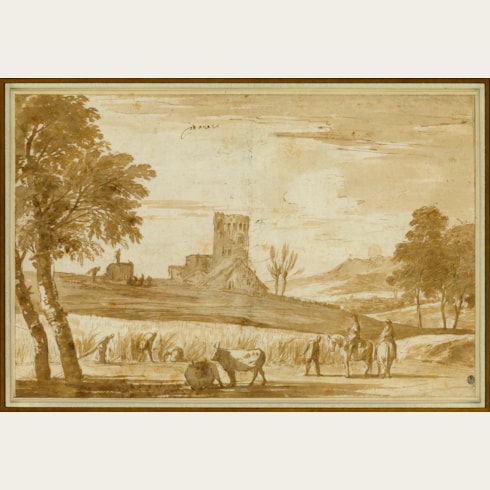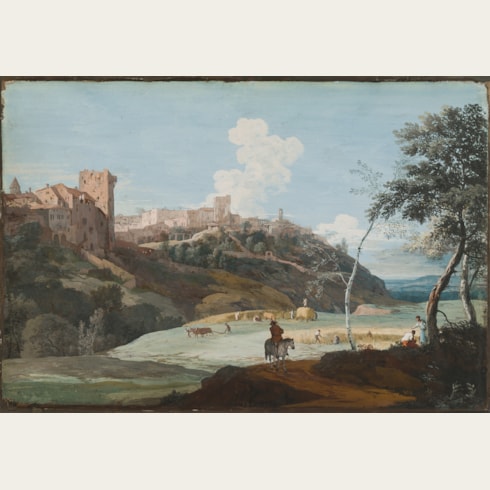Marco RICCI
(Belluno 1676 - Venice 1730)
Winter Landscape with a Mill by a Frozen River
Tempera on kidskin, laid down on card.
340 x 445 mm. (13 3/8 x 17 1/2 in.) [sight]
340 x 445 mm. (13 3/8 x 17 1/2 in.) [sight]
Although few of his gouache landscapes on kidskin are firmly datable – indeed, hardly any of his paintings or drawings are signed or dated - Marco Ricci had probably begun to produce them by the time of his second visit to England in 1712, to judge by the fact that many of them ended up in English collections. As early as 1716, the critic George Vertue had praised the artist’s ‘ruins in oil, and better in water-colours, and land-storms’. The numerous examples of Ricci’s gouache landscapes in the Royal Collection – Consul Smith came to own more than thirty of these delightful works - and in other English collections attests to their popularity with Vertue’s contemporaries. Finished works of art intended to be framed and displayed, a few of these tempera landscapes are among the artist’s last works, bearing dates between 1727 and 1729. That these gouaches continued to be highly prized long after Ricci’s death can be seen in the comments of the 18th century Venetian collector and connoisseur Anton Maria Zanetti the Younger, writing in 1771, who noted of the artist that ‘negli anni virili si pose a dipingere a tempera su pelli di capretto, ora scure, ora bianche, con gran vaghezza e felicissima verità.’
Ricci’s use of kidskin as a support allowed the layers of bright, opaque gouache to achieve a particular brilliance and luminosity in these landscapes of the Venetian territories. As William Barcham has pointed out of the artist, ‘Why he chose goatskin instead of calfskin [i.e. parchment] is unclear, but his success with this novel combination of paint and support is demonstrated by the number of works he executed in this manner and by his results, which are singular and felicitous. He used paint on goatskin in a number of ways, sometimes painting in a sketchy manner and leaving the skin’s texture bare, at other times applying thick daubs of colour to produce an opaque and richly textured finish. The bright tonalities and smooth surfaces Ricci achieved in this genre were a response to the same early 18th-century taste that judged pastels attractive.’
This atmospheric winter landscape is a particularly fine example of Ricci’s work in gouache. Winter subjects are uncommon in his oeuvre, although he must have experienced similar freezing conditions and snow in the region around his birthplace of Belluno in the Dolomites. He may likewise have been inspired by similar winter scenes among the 17th century Dutch landscapes that he could have studied in the collections of some of his patrons during his stay in London. (The artist may also have travelled through the Netherlands on his way between Venice and England.) As the Ricci scholar Annalisa Scarpa Sonino has noted of the artist’s rare winter subjects, ‘There is no attempt at embellishment or a capricious intervention in the effects of nature: winter, with its dried-up, snow-covered branches, leaden sky and frozen water, dominates the whole scene; and the meteorological ‘status’ portrayed is what Marco sees and feels in his constant, intimate contact with nature.’
A painted version of this winter landscape, executed on canvas, is in a private collection. A similar composition is also found in a gouache landscape with men gathering timber by a frozen river, recently sold at auction and now in a private collection in London, which was one of a set of five gouaches by Ricci probably acquired in Italy in the first half of the 18th century by George Proctor of Langley Park in Norfolk. Scarpa Sonino’s description of the ex-Langley Park gouache is equally relevant to the present sheet: ‘The Winter Landscape is one of the most pleasing of Marco’s depictions of this theme. Recollections of the Low Countries emerge with the vividness of immediacy; the great cylindrical tower with all its bulk repeats architectural structures created by Ricci in a large number of landscapes and views dating from between the second and third decade [of the 18th century], the period in which we could also date these paintings.’
Among a handful of other, similar winter landscapes in gouache or tempera by Marco Ricci is one in the Royal Collection at Windsor Castle, of which a variant was in a private collection in Milan in 1956. Another comparable gouache winter scene was formerly in a private collection in London and is now in a private American collection.
A slightly smaller copy of the present sheet appeared at auction in London in 1999.
Ricci’s use of kidskin as a support allowed the layers of bright, opaque gouache to achieve a particular brilliance and luminosity in these landscapes of the Venetian territories. As William Barcham has pointed out of the artist, ‘Why he chose goatskin instead of calfskin [i.e. parchment] is unclear, but his success with this novel combination of paint and support is demonstrated by the number of works he executed in this manner and by his results, which are singular and felicitous. He used paint on goatskin in a number of ways, sometimes painting in a sketchy manner and leaving the skin’s texture bare, at other times applying thick daubs of colour to produce an opaque and richly textured finish. The bright tonalities and smooth surfaces Ricci achieved in this genre were a response to the same early 18th-century taste that judged pastels attractive.’
This atmospheric winter landscape is a particularly fine example of Ricci’s work in gouache. Winter subjects are uncommon in his oeuvre, although he must have experienced similar freezing conditions and snow in the region around his birthplace of Belluno in the Dolomites. He may likewise have been inspired by similar winter scenes among the 17th century Dutch landscapes that he could have studied in the collections of some of his patrons during his stay in London. (The artist may also have travelled through the Netherlands on his way between Venice and England.) As the Ricci scholar Annalisa Scarpa Sonino has noted of the artist’s rare winter subjects, ‘There is no attempt at embellishment or a capricious intervention in the effects of nature: winter, with its dried-up, snow-covered branches, leaden sky and frozen water, dominates the whole scene; and the meteorological ‘status’ portrayed is what Marco sees and feels in his constant, intimate contact with nature.’
A painted version of this winter landscape, executed on canvas, is in a private collection. A similar composition is also found in a gouache landscape with men gathering timber by a frozen river, recently sold at auction and now in a private collection in London, which was one of a set of five gouaches by Ricci probably acquired in Italy in the first half of the 18th century by George Proctor of Langley Park in Norfolk. Scarpa Sonino’s description of the ex-Langley Park gouache is equally relevant to the present sheet: ‘The Winter Landscape is one of the most pleasing of Marco’s depictions of this theme. Recollections of the Low Countries emerge with the vividness of immediacy; the great cylindrical tower with all its bulk repeats architectural structures created by Ricci in a large number of landscapes and views dating from between the second and third decade [of the 18th century], the period in which we could also date these paintings.’
Among a handful of other, similar winter landscapes in gouache or tempera by Marco Ricci is one in the Royal Collection at Windsor Castle, of which a variant was in a private collection in Milan in 1956. Another comparable gouache winter scene was formerly in a private collection in London and is now in a private American collection.
A slightly smaller copy of the present sheet appeared at auction in London in 1999.
Marco Ricci received his artistic training in the studio of his uncle Sebastiano Ricci, with whom he often later collaborated. A landscape painter first and foremost, he completed the landscape backgrounds in Sebastiano’s canvases, and is also known to have assisted other artists, including the Genoese painter Alessandro Magnasco. Marco Ricci worked initially in Venice, although he fled the city in the late 1690s after killing a gondolier in a tavern brawl, apparently by breaking a jug over his head. He returned to Venice in the early years of the 18th century, and later worked in Florence and Rome. He also developed a reputation as a theatrical painter, working in this field in Venice and London. In the autumn of 1708, at the invitation of the British ambassador in Venice, Charles Montagu, 4th Earl (later Duke) of Manchester, Ricci made the first of two trips to England. He worked alongside Giovanni Antonio Pellegrini on the decoration of Burlington House in London, Kimbolton Castle in Cambridgeshire and Castle Howard in Yorkshire, and also designed scenery for the Italian Opera at the King’s Theatre, Haymarket. He left England in 1710 but returned for a second time with Sebastiano in 1712, remaining there until 1716 before returning to settle in Venice. Together with his uncle and several other prominent artists, Ricci was commissioned by the entrepreneur Owen McSwiny to paint a series of allegorical tombs dedicated to prominent English noblemen; his Monument to the Duke of Devonshire was completed in 1725. In many of his paintings, gouaches and drawings can be seen the particular influence of the Dutch and Flemish landscape tradition of the previous century. Furthermore, as one recent scholar has noted, ‘Evidently Ricci was prepared to try his hand at different styles and techniques. He was receptive to varying landscape styles, agreeable to collaborative efforts, willing to produce different types of imagery, and capable of painting pastorals or storms, delapidated ruins or busy little towns, in either oils or tempera.’ Perhaps encouraged by the connoisseur and publisher Anton Maria Zanetti, Ricci took up printmaking around 1723. Some thirty-three etchings by him are known, twenty of which were included in the series Varia Marci Ricci Pictoris Praestantissimi Experimenta, published by Carlo Orsolini in Venice in 1730, the year of the artist’s death.
As a draughtsman, Marco Ricci is best known for his landscapes drawn in pen and ink, as well as for the distinctive gouache landscapes that he had begun to produce by the time of his second visit to England in 1712, and which appear to have been his invention. Two large collections of Ricci’s drawings were formed in his lifetime; that of Zanetti, who owned 141 drawings by the artist mounted into an album, now dispersed, as well as a large number of gouache landscapes, and that of Consul Joseph Smith, whose collection of 146 drawings, 32 gouaches and 136 caricatures by Ricci is today in the Royal Collection at Windsor Castle.
Provenance
Two unidentified red wax seals on the backing board.

